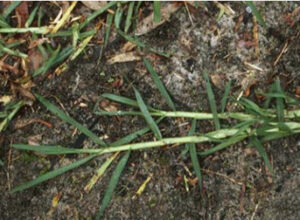Life cycle: Kikuyu is perennial and winter dormant. It flowers between October and March.
As a soil indicator: Kikuyu is an indicator of very low calcium and phosphorus, high potassium, very high magnesium and iron, low humus in soil, compacted soils and low soil bacteria.
Beneficial attributes: Kikuyu can stabilise sandy soil and reduce erosion.
Negative attributes: Kikuyu impedes water flows in drains, can be a fire hazard, forms dense mats and smothers most other species.
Dispersal: Kikuyu spreads locally by creeping stems and spreads more widely via dispersion of stem fragments by cultivation.
Legislation: None
Non-chemical control methods: Clean cultivating and slashing equipment thoroughly to reduce spread to clean areas, especially from late spring to autumn.
Manual eradication of kikuyu grass is very difficult, as all surface runners and underground rhizomes must be removed. Careful consideration is required when deciding which weed control tools to use. Poorly timed or poorly executed weed control practices may spread this weed. For example, a poorly timed mowing pass can encourage seed set while a single cultivation pass with a rotary tiller can break up and spread the kikuyu runners. Most growers use a combination of tools and take advantage of hot dry weather to increase the efficacy of their non-chemical weed control practices.
Sheep grazing
Grazing kikuyu hard in autumn followed by hard grazing in late winter to spring can help to manage kikuyu going into the growing season; however, additional non-chemical weed control practices need to be used during the growing season to maintain control.
Organic herbicides
Slasher®, an organic herbicide, can give good, short-term, knock-down control during the season when applied just as the heads of the kikuyu start to emerge in spring, followed by a second application four weeks later. For the best results, Slasher® should be applied on a hot day, or before an extreme heat event, and applied it in the morning, after the morning dew has dried.
Cultivation and cover crops
Growers are achieving good control of kikuyu by cultivating it and then establishing a competitive crop to suppress it. For the best results, kikuyu patches should be cultivated in autumn, before a stretch of hot days. High temperatures help to kill the exposed kikuyu. If temperatures are mild, an application of Slasher® can be applied to mimic high temperatures.
An aggressive cultivating tool may be required to get under thick thatches of kikuyu. A disc cultivator followed by a power harrow have been used effectively by some growers. The disc cultivator breaks up the soil and the power harrow pulls the kikuyu up. A dodge plough is also effective at pulling the kikuyu into the mid-row.
The cultivated kikuyu patches should be sown with a sufficiently competitive cover crop as soon as possible. Crops effective at suppressing kikuyu are wheat, triticale, barley, oats, cereal rye, fodder radish, oil-seed mustard, canola, wallaby grass and creeping saltbush. When selecting a cover crop, it is important to consider the minimum rainfall required to support the crop and the growing habit of the crop. Tall growing crops are more suited to the mid-row area (Table 1); however, they can be used undervine provided a method to prevent them from growing into the vine canopy is available. This might involve undervine mowing, whipper snipping or sweeping.
Table 1. Cover crop options for the mid-row and undervine area of vineyards in different rainfall zones
| Minimum rainfall | |||
| Area of the vineyard | 500 mm | 350 mm | 250 mm |
| Mid-row | Fodder radish | Barley Oil-seed mustard Canola Wallaby grass |
Wheat Triticale Oats Cereal rye Creeping saltbush |
| Undervine | Clovers | Annual ryegrass Subclovers |
Medics |
Solarisation
Solarisation can provide reasonable control of kikuyu when the kikuyu is completely covered with plastic sheets for 8-12 weeks in hot weather. After the plastic sheets are removed, regrowth can be controlled with either organic herbicide applications, multiple cultivation passes or a combination of cultivation and the establishment of a competitive cover crop.

Figure 1. Kikuyu (courtesy of HerbiGuide http://www.herbiguide.com.au)
Growers’ experiences: Gemtree in McLaren Flat, SA, has achieved excellent control of kikuyu by establishing an annual crop of cereal rye undervine, taking advantage of its allelopathic properties.
Resources
HerbiGuide (HerbiGuide website)
Henschke Wines: A non-chemical weed control case study from the Adelaide Hills, SA
Gemtree Wines: A non-chemical weed control case study from McLaren Vale, SA
Contact
For further information, please contact:
AWRI helpdesk
Phone 08 8313 6600 Email helpdesk@awri.com.au

